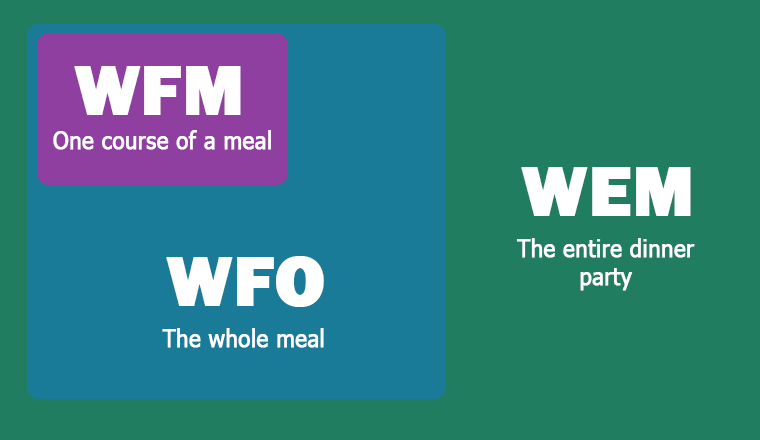13th September 2022

Effectively managing contact centres and employee performance requires the right strategies and tools.
Three commonly used terms in this space are WFM, WFO, and WEM, and while they may sound similar, each represents a distinct approach to optimising workforce operations, improving efficiency, and enhancing employee engagement.
Understanding the differences between these concepts is key to selecting the right solutions for your organisation’s needs.
To find out more, we asked Dave Hoekstra , WFM Evangelist at Calabrio, and Paul Turner, WEM Innovation Lead at Genesys, to explain the key differences between Workforce Management (WFM), Workforce Optimization (WFO) and Workforce Engagement Management (WEM).
Watch the video below to hear Dave and Paul discuss the key differences between WFM, WFO and WEM:
With thanks to the following people for contributing to this video:
Workforce Management (WFM) is primarily focused on efficiency and resource allocation. At its core, WFM ensures that organisations have the right number of agents, with the right skills, scheduled at the right times to meet anticipated demand.
This approach is essential for maintaining service levels in contact centres, ensuring rapid response times and efficient handling of calls.
As Paul Turner at Genesys explains “Workforce Management mainly focuses on efficiency, supply and demand, ensuring that you have the right resources in at the right time. These solutions were generally around things such as service level, or speed of answer, or perhaps even occupancy.”
Key aspects of WFM include:
WFM focuses on scheduling and deploying resources effectively to meet customer needs.
Workforce Optimization (WFO) takes WFM a step further by linking it with other tools to enhance both efficiency and effectiveness.
WFO brings together tools for recording, quality management, and performance analytics, helping contact centres optimise not only their operations but also employee performance.
“Workforce Optimization was created when we started to link WFM solutions to other solutions, such as recording, quality management and performance management. Then we lifted that efficiency to the effectiveness of our employees.” – Paul Turner
Dave Hoekstra explained that “If you look at Workforce Management, ‘management’ is a term that has a specific connotation. Then we move to Workforce Optimization, the ‘O’ has another connotation to it. And both of those are kind of implying that these are resources that need to be managed, and optimized, and very efficient, and really driving towards the optimization goal.”
With WFO, organisations add tools such as:
WFO shifts the focus from mere scheduling to optimising the overall performance and quality of service.
“WEM stands for Workforce Engagement Management, and it’s the evolution of the tools and the resources being managed.
WEM expands the suite out into the role of how we really need to be engaging these resources, and making sure that they feel like they’re part of the overall success of the organization. As opposed to something that’s being optimized or managed.” – Dave Hoekstra
Workforce Engagement Management (WEM) is the latest evolution, focusing on employee engagement and satisfaction rather than just performance optimisation.
This approach aims to create a positive work environment where employees feel valued and engaged, thus improving retention and overall organisational success.
Paul Turner expanded on this by explaining:
“WEM builds upon WFO but then focuses on generating a positive experience for the employee.
You see additional things coming into that space, such as gamification and recognition, perhaps bringing in onboarding and recruitment, and things such as voice of the employee feedback, not just necessarily about the customer.”
WEM builds upon WFO by adding features that prioritise the employee experience, such as:
By focusing on employee engagement, WEM promotes a workplace culture that values employees’ contributions and fosters long-term success.
Here’s a look at how WFM, WFO, and WEM differ in focus, elements, and benefits:
| Area | Focus | Key Elements | Benefits |
|---|---|---|---|
| WFM | Efficiency | Scheduling, Forecasting, Service Level | Meets customer demand effectively |
| WFO | Efficiency & Effectiveness | Quality Management, Call Recording, Analytics | Improves service quality and agent performance |
| WEM | Employee Engagement | Gamification, VoE, Onboarding | Enhances employee experience and retention |
To better understand the differences between these terms, consider the analogy of a dinner party:

WFM is like a single course – the forecasting and scheduling of resources, ensuring that agents are at the right place, at the right time.
WFO is the entire meal – incorporating quality, call recording, and analytics to enhance the experience and effectiveness.
WEM is the whole dinner party – where we take into account the chefs, the waiters, the ambiance, and every element that contributes to a memorable experience, not just the food.
This analogy illustrates how each step expands the focus from mere scheduling (WFM) to overall experience (WEM), reflecting the growing importance of engagement in modern workplaces.
Or as explained in the video by Calabrio’s Dave Hoekstra:
“WFM is a part of the whole. Think of WFM as one course of a meal, and WFO is the whole meal. Well, we’ve now even moved to the new realm of WEM, where we might even be talking about the entire dinner party, as opposed to just the meal, where everything comes together.
WFM tends to focus very specifically on the forecasting and scheduling needs of the contact centre, getting the agent in the right place, at the right time, with the right skills. And WFO tends to include tools such as quality monitoring, call recording, speech analytics, it’s the entire suite of packages.
And we’ve moved to the new, latest, greatest term WEM, Workforce Engagement Management, which brings in even more tools.
So, we’re now talking about looking at the entire organization of the chefs and the waiters in the restaurant, and everything building into the dinner party. We just keep expanding our acronyms to larger and larger software suites.”
If you are looking for more great insights from the experts, check out these next:
Reviewed by: Robyn Coppell